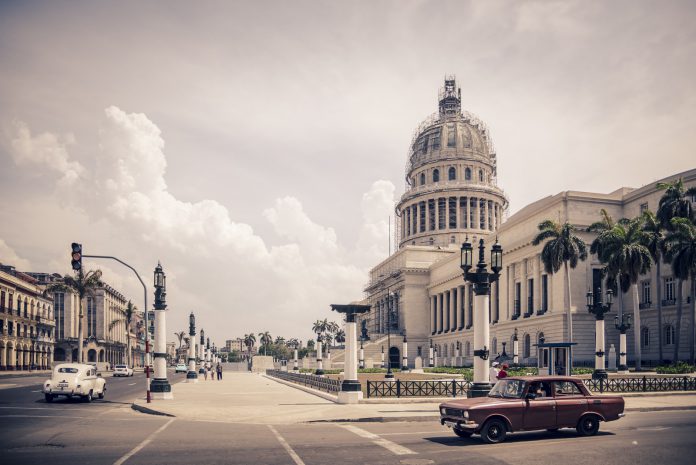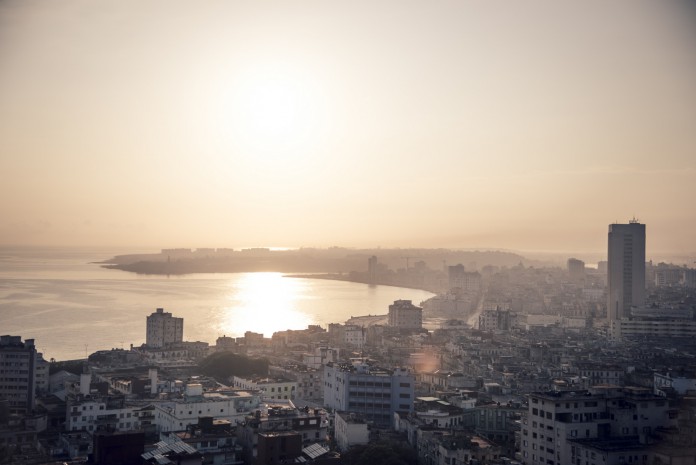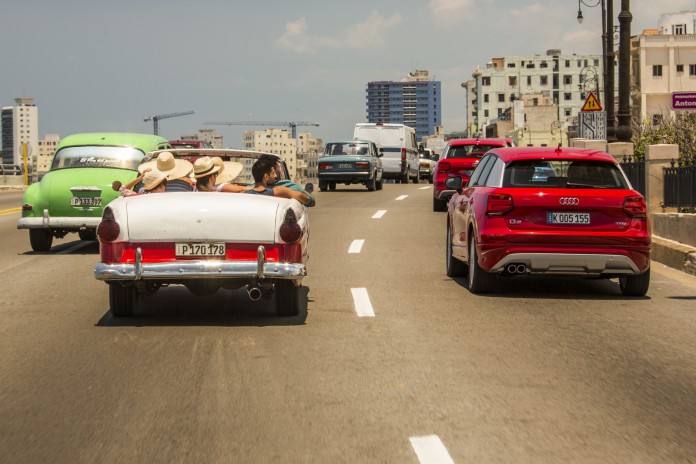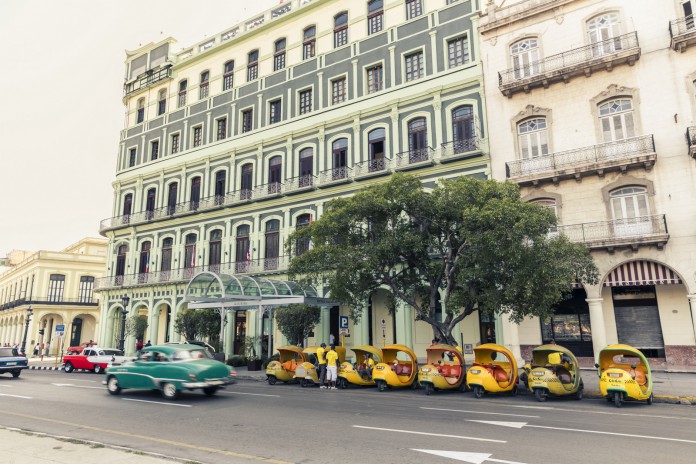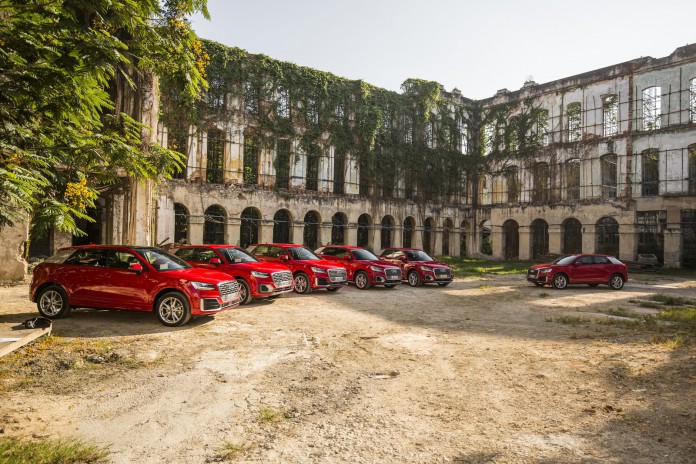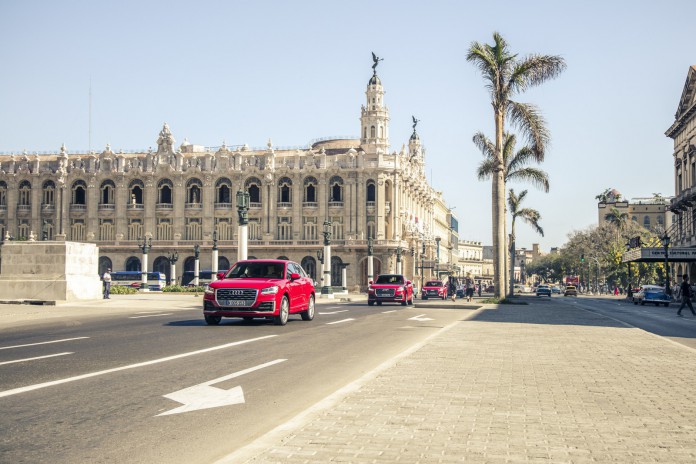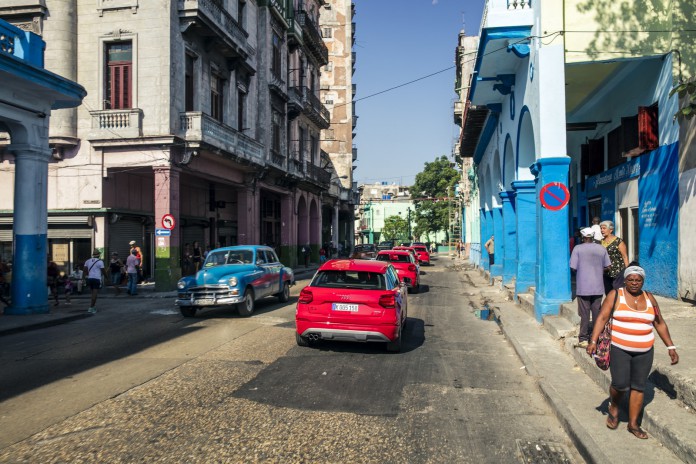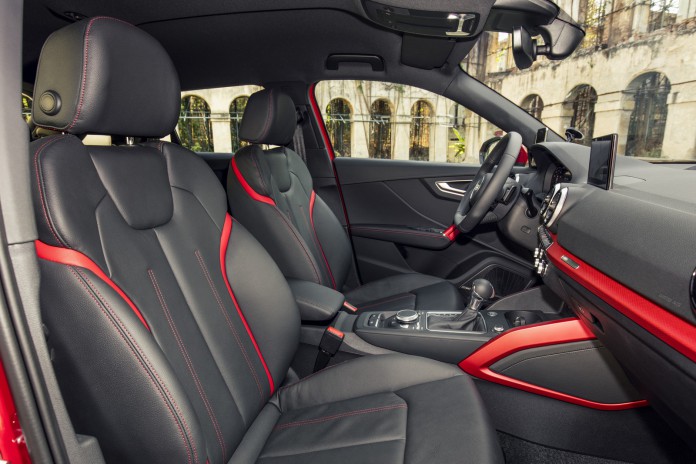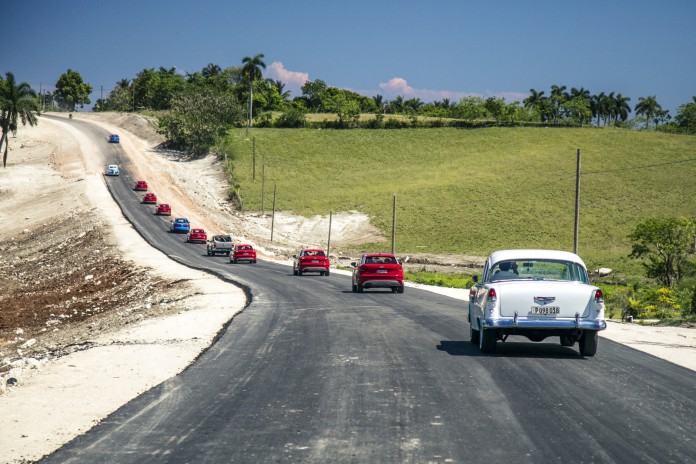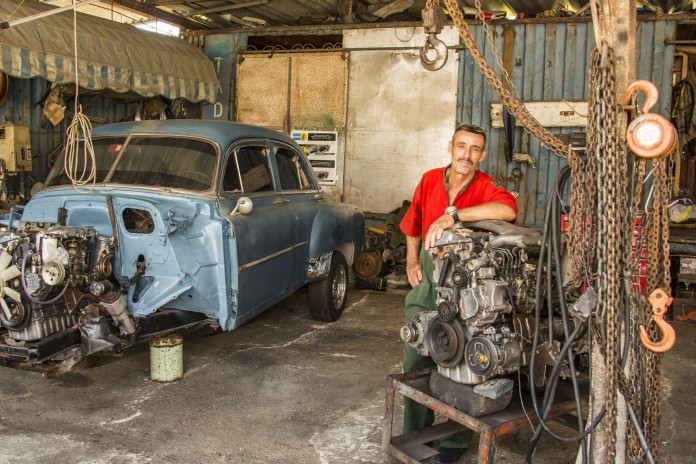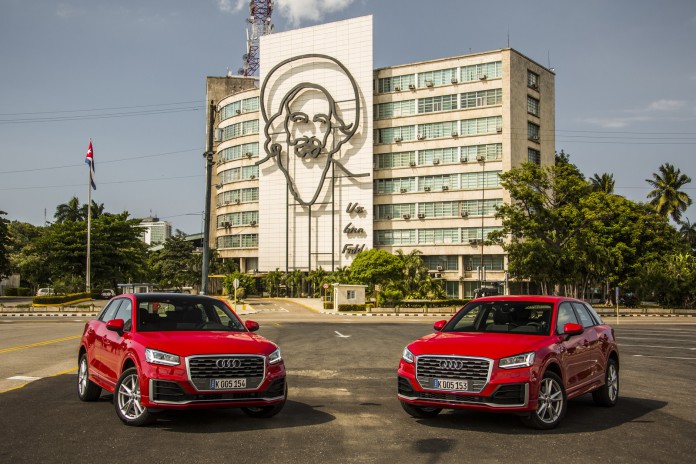For the first time since the 1950s a car launch took place in Cuba. The country in the Caribbean has been very closed since the revolution in 1959. But when Raul Castro took over power from his brother Fidel Castro in 2008 the Cuban government started to open up to the West, with the visit of US President Barack Obama and the launch of the new Audi Q2 as most recent highlight.
Audi chose Cuba’s capital Havana as unusual but spectacular location for the launch of its new city-SUV. A brave decision considering the bureaucratic hassle both the event organizers as the attending international media had to go through before they could drive the new Q2. In my case it meant filling out several forms, write a resume (for the first time in my life), have new passport photos taken and fill out some more forms before sending my passport to Berlin to get a journalist visa.
But with just a week to spare my passport returned with a shiny new visa for Cuba in it. Car launches generally last only a day or two and despite the distance and the visa hassle the Audi Q2 Cuban adventure would be no different. Scheduled to arrive on Sunday evening and depart on Tuesday again. That meant two nights and a bit in a place that long ranked among the top on my ‘places to go’ list.
I heard a lot of stories from friends and family that traveled to Cuba in recent years and all came back with colorful stories about the feeling of going back in time, the laid-back atmosphere and the friendly people. Since 1965 Cuba is governed by the Communist Party and knows a history of ups and downs. As a car guy one of the most well known effects of the sanctions against the regime and the communist regime are the scarce supply of new cars and the enormous collection of still-in-use pre-1959 American cars.
The idea of driving a brand new car in a country where the roads are dominated by cars over 50 years old was rather exciting, even when the Audi Q2 might not be as exotic as other cars we review at GTspirit.
On arrival in Havana I found myself in the humid and crowded arrivals hall of Havana international airport – immigration went surprisingly smooth, it took only 10 minutes from plane to the arrivals hall through immigration, security and customs. Hand luggage giving me a clear advantage, although I heard plenty of stories of long cues at the immigration counters too. As I walked out from the airport hall the first thing that hit me was the hot tropical air. The kind of sticky, 32C hot air that makes you want to shower five minutes after it hit you.
The next thing I noticed however was a lot more pleasant. Some beautiful American 1950s Chevrolet and Buicks drove past as we waited for our shuttle bus. American cars were not the only cars you could see at the airport arrivals area. It presented an interesting mix of 1950s cars, Soviet Ladas and Volgas, 1980s Peugeots and an array of recent imports, mostly Asian with some European cars.
Our airport transfer showed up in the form of a fairly new mini van of some Chinese make I can’t recall. The air-conditioning worked well and that was all that mattered at that point after my long haul flight from Amsterdam and the hot smack in the face. The 30 minute ride to the hotel was an experience in its own. Not far from the airport the scenery changed from fields and farms to city and I soon got the impression I really travelled back in time. Petrol stations looked to come straight from an old movie and classic architecture mixed with some Soviet-style factories and low-rise buildings.
The roads were interesting too, very wide but in poor condition. Potholes are very common and you also have to be aware of people walking on the road and cars that suddenly stop to pick someone up and drop someone off. The closer we got to the center of Havana the better the roads became. According to one of our drivers this had to do with the visit of the Pope two years ago and the recent visit of Obama that saw a lot of the roads along their route repaved.
As we approached Plaza de la Revolucion the wide avenue with palm trees and a highrise building could give you the feeling you are in Miami. But as we drove further there was no mistaking; this is Cuba. At Plaza de la Revolucion there are two government buildings whose facades bear huge steel memorials of Che Guevara and Camilo Cienfuegos. From the huge square it was only a few more minutes to our hotel, the 1950s Habana Libre. The largest hotel in Havana and originally built by Hilton, the architecture again reminds me of Miami with a large concrete drive and huge lobby. As with many other buildings in Cuba a renovation is long overdue though.
Following a relaxed dinner and drinks in Havana tension was rising the next morning for the thing I am here to do: test drive the new Audi Q2 on the streets of Cuba. In front of the lobby a set of beautiful 1955 Chevrolet Bel Airs appeared; our shuttles to the center of Havana. Most of them run with more modern diesel engines from various makes but I was lucky and found myself in a Bel Air with an original 1950s V8 engine. Few people know, but there is an annual Concours d’Elegance in Havana where the most original and best restored classic cars in Cuba are awarded.
As we pulled up to the hotel Saratoga, one of the most luxurious hotels in Havana, my eye caught something that didn’t quite look like the new Q2. Instead Audi added another typical type of transport found in Havana; the four seater banana scooter. Like a proper tourist we travelled the last few hundred meters with these funny looking scooters. In the courtyard of an old hotel of which only the outside walls remain Audi lined up six brand new red Audi Q2s and two support Q7s. They were shining away in the bright sunlight with temperatures well over 30 degrees already at this early hour.
A small briefing from the main project designer and key engineer explained a lot about the how and why of the Q2. Goal was to create a compact car for the city with enough space and abilities to use it in the weekend also. All six Q2s Audi brought to Cuba had a 1.4 liter four cylinder petrol engine. In total there are three petrol engines (3 cyl 1.0 liter and a 1.4 and 2.0 liter four cylinder) and three diesel engines (1.6 and 2.0 liter four cylinder engines). One of the greatest challenges for Audi in preparation of the Q2 drive was finding high quality petrol as the fuel quality at many petrol stations is far from ideal. In the end even some fuel was pumped out of the Q7s that were shipped with a full tank of German quality petrol to Cuba so the cars performed as they should.
The Q2 opens up a new segment for Audi with a premium city SUV that customers can spec almost like an A8. Believe it or not but virtually every option you can get on other Audis is also available for the Q2. The Audi Virtual Cockpit that replaces the analogue speedometer and rev counter is standard on the Q2. A 7-speed S Tronic dual clutch gearbox is available as optional extra with all engines. Audi Quattro is also optional, standard it is front wheel drive.
Before we set off there was a final instruction about our drive which included a police escort all the way. With the instructions of the police in mind it was time to go. From the outside I didn’t expect that much space inside the 4.19 meter long Q2, but even with three people in the car there is a lot more space than the average sportscar and you have a decent size luggage compartment too. This is mainly thanks to very short overhangs front and back and a fairly short nose.
The center of Havana is nicely restored and although you don’t see that many new cars the Q2 blended in nicely here. But on our drive to a finca 30 kilometers outside Havana we soon found ourselves in the real Havana; streets with old buildings that seem to slowly fall apart and roads with large holes in it. As I focused on avoiding the worst holes a classic motorcycle with one of our policemen flew by as he raced from intersection to intersection to guarantee our group a safe and quick passage. It was interesting to see the lack of shops along the busy streets and when there was a shop there was always a long cue in front of it. Most citizens rely on coupons to buy food and essential clothes. Luxury amenities like televisions and computers are virtually only brought in by relatives from abroad, everybody did seem to have a Smartphone though. Internet is also not that easy to access, even in our hotel you had to buy hourly tickets at a dedicated shop to access the internet – when you could access it at all as it was so slow. Luckily the Audi Q2 came with a Cuban sim card and wifi hotspot so we could deal with our no-internet withdrawal symptoms.
The first Audi Q2 I drove came with the optional adaptive dampers. In comfort it absorbed most bumps nicely, the dynamic setting was a bit too much for the Cuban roads but the few kilometers I tried it indicated a good bandwith between the comfort and dynamic setting. Cornering wise the Q2 does nicely, little body roll and a pretty direct steering – it adds to a sporty overall feel.
The 1.4 liter petrol produces 140hp, enough in the city and for day to day business but if you want to use it for longer weekend trips I would opt for the 2.0 liter petrol or diesel engines that both produce 190hp.
As we cross the neighbourhoods in the South West of Havana people regularly stop in their tracks to watch the group of Q2s pass by. More than once they wave and whip out their smartphones to take a photo. I was under the impression that most classic American cars would roam around the tourist center of Havana but the further we get away from the center the more old cars there are on the streets.
Looks wise I quite like the front of the Q2, sporty and makes it appear larger than the car really is. On the side you can customize the car by chosing a different color side blade, which you can also change at the dealer whenever you wish. The rear reminds me a lot of the Volkswagen Polo and although the individual details like the rear spoiler and the diffusor are nice, the overall look of the rear doesn’t appeal to me.
Inside Audi continues the style they introduced with the new TT, very clean and cool design. The controls of the infotainment changed once again and is different from most Audis on the market today but I still have hope Audi find controls they can implement across the range soon. With the Audi Virtual Cockpit you don’t really need the second infotainment screen on top of the center console anymore but for passengers it is nice to have and essentially gives you two screens to play with. I often used the display behind the steering wheel for navigation and the other screen for infotainment.
At the Finca we had time for some refreshments and a driver change. The next part of our journey saw us hit the coast and continue all the way to the other side of Havana to one of the most famous beaches near Havana: Playa del Este. On the way there we drove a mix of country roads and highways. Driving on the highways near Havana you have the feeling they once had very big plans for cars in Cuba with 8-lane highways and intersections with overpasses that are running far under capacity. The lack of traffic makes Cuba a great place to drive if it weren’t for the huge potholes and lack of maintenance. Also don’t be surprised when you see people and animals walk across the highway.
Playa del Este is a beautiful white sand beach with palm trees swinging in the wind. Sadly we had not much time to enjoy it as we had one more stop planned at the classic car garage of Horge Hernandez. Together with his six employees he restores between 20 and 25 classic cars a year. A full restoration costs upwards of 10,000 USD, a fortune for most Cubans whose average salary is around 40 USD a month. Most restorations are funded by Cubans living abroad who pay to have the car of a family member restored. With a good looking American classic car Cubans can earn a very decent salary as taxi driver, probably one of the best paid jobs in the country.
The biggest challenge for Horge and his team is getting parts though. Even though he can have parts shipped directly with UPS from the United States now, there is still a shortage for many parts and tools in Cuba. Horge hopes the classic car scene remains intact even when more new cars will come to Cuba every year. He understands many Cubans replaced the large inefficient V8s with smaller diesel engines in their classic cars but he hopes at some point they will be returned to their original state.
As member of the Cuban classic car association Horge is also involved with the annual Concours d’Elegance for classic cars. All the cars that are approved receive a special indication as ‘original’ with the number they were in the concours. Most participants wear the sticker proudly on their cars and as you walk around Havana you can spot the Concours participants easily. A good way to know which taxi to pick if you want to drive in an original 1950s car and not just the body with a Asian or European diesel engine. To protect the unique car scene the Cuban government forbids export of the classic American cars out of Cuba.
When we drove back from the workshop to Havana a new member joined the escorting duties – an ambulance stopped traffic on intersections to give us clear passages. I have experienced quite a lot but being escorted by an ambulance was definitely the first time. Back in Havana we stopped at the Plaza de Revolucion again for one final photo shoot.
Our final stop of the day was the famous hotel Nacional dating back to 1930. Located directly on the Malecon boulevard and overlooking the ocean it was the place where Obama stayed recently. With the driving duties behind us we enjoyed a nice cold Cuban beer on the terrace.
The Audi Q2 was a great travel companion for our little Cuban roadtrip and besides parts of its looks we found nothing to complain about, if it can survive on the streets of Cuba it will do well everywhere else!
Havana was a great place to be. The city center is a bit like Disneyland already especially when one of the few cruise ships that visit Havana from Miami are in town. But if you leave the city center behind, you really travel back in time 60 years with classic cars, old architecture and very friendly people. If you haven’t been, visit Cuba as soon as possible!


